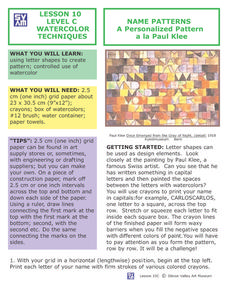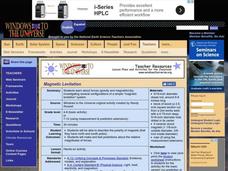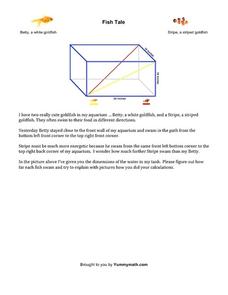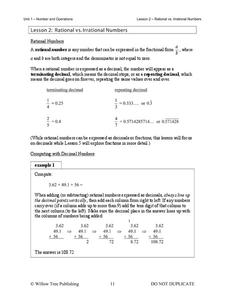Curated OER
Converting Fractions to Decimals
These fractions need to be converted to decimals, but no calculator is needed. Scholars examine two examples which explain the process briefly before completing 16 fractions with denominators of either 10 or 100. For the next section...
Curated OER
Name Patterns
Here is a fun, colorful, and engaging art project that is sure to get your kids excited! They make a piece of art using watercolor paints, and by making a design out of the letters of their first name. This would be a fantasti art...
Curated OER
Magnetic Levitation
A thorough investigation of magnetic levitation; this activity has four parts. First, physical scientists play with a wooden dowel and three disc magnets to review polarity and repelling action. Then they experiment with...
Curated OER
Fractions Lesson 4
As this slide show explains, simplifying a fraction is very similar to finding an equivalent fraction. The process to simplify fractions is fully demonstrated and clearly explained, 15 practice problems are included.
Get Set for School
Number Formation Chart
Help young learners write their numbers with a number formation chart. It illustrates the way their pencils should move when they make each number, along with a cute story about what each number is doing and thinking as it is being written.
Curated OER
Monster Frog Function Machine
Elementary schoolers use a function machine in order to help them look at the relationship between input and output, and to look at the rule for the change. The machine is actually a cardboard box, and it serves quite well for the lesson...
Scholastic
Spring Is Sprung: Water Movement in Plants
Young scientists use food coloring and celery stalks to determine how water travels through plants.
Curated OER
Does Soil Get Soggy?
Study the properties of soil and water absorption with a science activity. Based on a paragraph with background knowledge on sandy soil, silt, and clay soil, third graders choose which illustration represents a bottle full of sandy soil....
Serendip
Get the Lead Out!
Around 500,000 children under the age of six suffer from elevated levels of lead in their blood in the United States. Scholars apply their knowledge about lead to a fun game. As they correctly answer questions, they move their pieces...
Curated OER
Fabric Scrap Flower Garden
Crafting is fun, it increases eye-hand coordination, and it is a great way to accent any lesson. Celebrate Earth Day by creating scrap fabric flowers for a pop-stick flower garden. Children of all ages will love gluing, cutting, and...
Exploratorium
Magnetic Shielding
Elementary magnetologists investigate magnetic shields using a variety of materials in a "shielding sandwich." While the activity isn't novel, it is engaging, and this particular resource includes a brief explanation of the phenomena...
DiscoverE
Sun-Warmed Treats
Treat your class to a fun activity, complete with treats. Groups create a solar oven from a pizza box. They then use it to heat up some food ... that's what an oven is for, after all!
Curated OER
r and n
Here is some kid-friendly practice with the letters r and n that will ignite your scholars' artistic sides. They connect the dots to trace the lowercase letters before copying them in the space provided. There are two...
Curated OER
View Tubes: Student Worksheet
Here is a worksheet that is almost a lesson! In it, learners conduct an experiment in which they determine the size of objects when viewed through viewing tubes. This resource has all of the instructions and tables necessary to complete...
Curated OER
Hollywood Squares
If you need a game to recap a unit of study, but your class is tired of Jeopardy, then this version of Hollywood Squares might be just what you are looking for. The questions are a great review on the basics of the circulatory system,...
Curated OER
Inequality and the 1/2 Benchmark
Fourth graders utilize fraction bar manipulatives to compare a variety of fractions to the fraction value 1/2. Pupils are put into groups, and they begin to see how fractions that look completely different actually represent the same...
Curated OER
Word Square: Ender's Game
Ansible. Hegemony. Candor. Readers of Orson Scott Card's Ender's Game create word squares for vocabulary words drawn from this award-winning science fiction novel.
Curated OER
Taco Grande
What do you use to chop an onion or brown the meat? Learners with special needs read through a taco recipe, then use it to complete three different academic development activities. They circle the best utensil for the job, match each...
Curated OER
Fish Tale
Here is a cute problem that requires visualizing two-dimensional shapes within a three-dimensional object, and using properties of triangles and the Pythagorean theorem to solve a real-world problem. There is a small mistake in this...
Novelinks
The Color of Water: Word Square Instructions
Immaculate, accumulation, dissipation. Vocabulary drawn from chapter 16 of James McBride's memoir, The Color of Water, can prove to be challenge for readers. To help kids understand the meaning of these words and what they add to the...
Computer Science Unplugged
Marching Orders—Programming Languages
Computers need precise directions to complete a task. Class members experience what it is like to program a computer with an activity that asks one pupil to describe an image while classmates follow the directions to duplicate the picture.
Willow Tree
Rational vs. Irrational Numbers
Build an understanding of rational numbers and their counterpart irrational numbers. Lead learners through an explanation of rational numbers and the ways they can be expressed. Then introduce them to irrational numbers and make...
Messenger Education
Mission: Possible—How Can We Plan an Exploration of Another World?
An astronaut's spacesuit weighs 280 pounds and takes 45 minutes to put on — that's a serious suit! The second activity of a three-part series allows pupils to see all that goes into space exploration. Through simulations, groups analyze...
Messenger Education
Exploring Exploring
The reason people first began trading was because of their desires for objects other societies possessed. In the activity, classes discuss why exploration has been a common thread in all societies and where these desires have taken...























